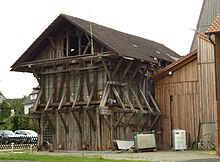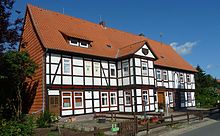Saline Sülbeck
The Saline Sülbeck is a salt works in Sülbeck in southern Lower Saxony that has existed since 1686 . The derrick from 1865 and 1882 and the brine reservoir from 1882 have been technical monuments since 1984 .
prehistory
Already in prehistoric times and well into the 1980s, brine springs appeared on the Dorfbach before it was piped . These were visible signs of salt deposits underground. From 1680 onwards, the development of the saltworks is a major difference between the development of the village of Sülbeck and its neighboring agricultural villages, of which only Salzderhelden had built their own saltworks .
Building history
The aspiring Welf territorial state had considered building a salt works in its search for income. On April 26, 1686, Prince Ernst August von Calenberg-Göttingen-Grubenhagen ordered that a “Saltz- und Leckwerck” should be built in Sülbeck . The project was run by Drost zu Salzderhelden, Otto Friedrich von Moltke , the last resident of the Heldenburg . At first, due to the high salt content of the brine of more than 9.4%, it was thought of directly boiling the brine. However, calculations showed that the cost of the wood required for this would have been too high. The project was greatly expanded and the construction of a graduation house to enrich the brine to around 20% salinity was planned. The graduation tower was approx. 166 m long and extended in a southerly direction from the current village square in Sülbeck.
In 1686 a main well and two small auxiliary wells were ready. In order to pump up the brine and feed the graduation house, a high pumping capacity was necessary. The only viable source of power at that time was water power, which, however, was not available in Sülbeck. Therefore a trench was dug to branch off water from the Leine in Hollenstedt and to lead about 6.5 km following the edge of the Leine valley around the villages of Stöckheim and Drüber to Sülbeck. At the edge of the current village square of Sülbeck, the canal made a bend of 90 ° from south to east and from there the water was fed back to the line. Around 100 Hanoverian soldiers dug this canal, which the residents called the Salzgraben , in about two years of construction. A large undershot water wheel on the current village square could then drive appropriate pumps. A stylized water wheel is an essential part of the town's coat of arms today. A brine tower was also built on the current village square in Sülbeck, from which the brine could be directed to the graduation tower. The industrial plant started operating in 1689. Soon other facilities, such as a second graduation tower, were added. Around 1700 the Saline Sülbeck with the graduation towers then produced around 300 tons of salt per year, production increased to 800 tons over the next hundred years.
In 1870 the salt works were privately owned by the Lockemann and Pflughöft families. Around 1897 the son of the salt works owner Hermann Lockemann, the chemist Georg Lockemann, worked in the salt works. In 1950 the Saline Sülbeck went bankrupt and the salt works were demolished. Only a small amount of brine was extracted from the remaining brine springs and from 1955 it was marketed under the new name Natursole Sülbeck . In 1988 the owner Elisabeth Lockemann transferred the salt works to her cousin Ulrich Birkelbach. At the beginning of the 20th century, the yield rose to over 5,000 tons. The upper derrick is housed in a half-timbered structure and was restored from 2006 to 2009 and has been a museum since then.
Two new wells were drilled in 2009. In total, the company Natursole Sülbeck Ulrich Birkelbach eK sold around 81,000 tons of brine per year with a salt content of 26.5 percent in 2014 and supplies around 50 percent of the brine to several thermal baths in Germany and the other 50 percent as de-icing salt for winter service and cleaning in of industry and a. as regeneration salt.
Infrastructure
port
The transport of the fuel necessary for salt boiling, initially wood, to the evacuation took place by horse and cart. The procurement of firewood has always been the biggest cost driver. Firewood was brought in from the Harz region . The formerly sovereign, now privatized salt works could now fall back on coal deliveries by rail . In 1883 the salt ditch was therefore expanded to include a small port in Sülbeck. The port was built directly on the current Deichstrasse in Sülbeck, opposite the village square (the area has been built on since 2010). First the ships were grained . In 1886 a steam tug was procured that could pull barges with coal up the salt ditch from Salzderhelden to Sülbeck. Two locks were built to overcome the difference in altitude between Sülbeck and the confluence of the salt ditch with the Leine . The first tug "Theodor" was later replaced by the more powerful tug "Grubenhagen". After the construction of a cable car, shipping was abandoned. The salt ditch was later filled in full length as part of the construction of the Salzderhelden flood retention basin in the 1970s.
Cable car
In 1908, the construction of a cable car system to transport coal from the Salzderhelden station to Sülbeck began. The cable car began at the train station in Salzderhelden, was led through the Leinewiesen to Sülbeck, crossed the current Deichstrasse and the Salzgraben and ended on the saltworks site on the current village square. This plant remained in operation until the salt works was completely closed due to bankruptcy in 1950. After that, like many of the redundant buildings, it was demolished. The concrete foundations of the cable car supports are partially preserved in the Leinewiesen.
Electricity and telephone
In 1899 a small hydropower plant with two turbines was installed in Sülbeck. Electricity was introduced in Sülbeck and Drüber on December 22, 1899. Shortly thereafter, Vogelbeck followed on the other side of the Leine, on July 1, 1903, Stöckheim . For comparison: The city of Northeim only received electric light in 1912. A telephone connection between Hollenstedt and Sülbeck was installed as early as 1894, the first in the area. It was used to quickly regulate the flow of water into the salt trench from the Leine.
Web links
- Homepage of the Heimatverein Leinetal eV with information and photos about the upper derrick of the Saline Sülbeck
- Homepage of the natural brine Sülbeck
literature
- Gernot Schmidt: The praiseworthy Saltzwerck zu Sülbeck. History and development of a saltworks in Lower Saxony. Publishing house of the German Mining Museum. Bochum 1995. ISBN 3-921533-55-4 (The book offers a complete overview of the development of the saline in Sülbeck and contains an extensive picture attachment)
- Georg Lockemann : The founding of the Saline Sülbeck, in: Archive for the history of natural sciences and technology, Vol. 6 (1913) pp. 241–250
swell
- ^ Georg Schambach, Wilhelm Müller: Lower Saxony sagas and fairy tales, 1855, p. 360
- ↑ Gernot Schmidt: The praiseworthy Saltzwerck zu Sülbeck . German Mining Museum. Bochum 1995, p. 20.
- ↑ Gernot Schmidt: The praiseworthy Saltzwerck zu Sülbeck . P. 22
- ↑ Gernot Schmidt: The praiseworthy Saltzwerck zu Sülbeck . P. 91
- ↑ a b Gernot Schmidt: The laudable Saltzwerck zu Sülbeck . P. 92
Coordinates: 51 ° 46 ′ 17.7 ″ N , 9 ° 55 ′ 7 ″ E


